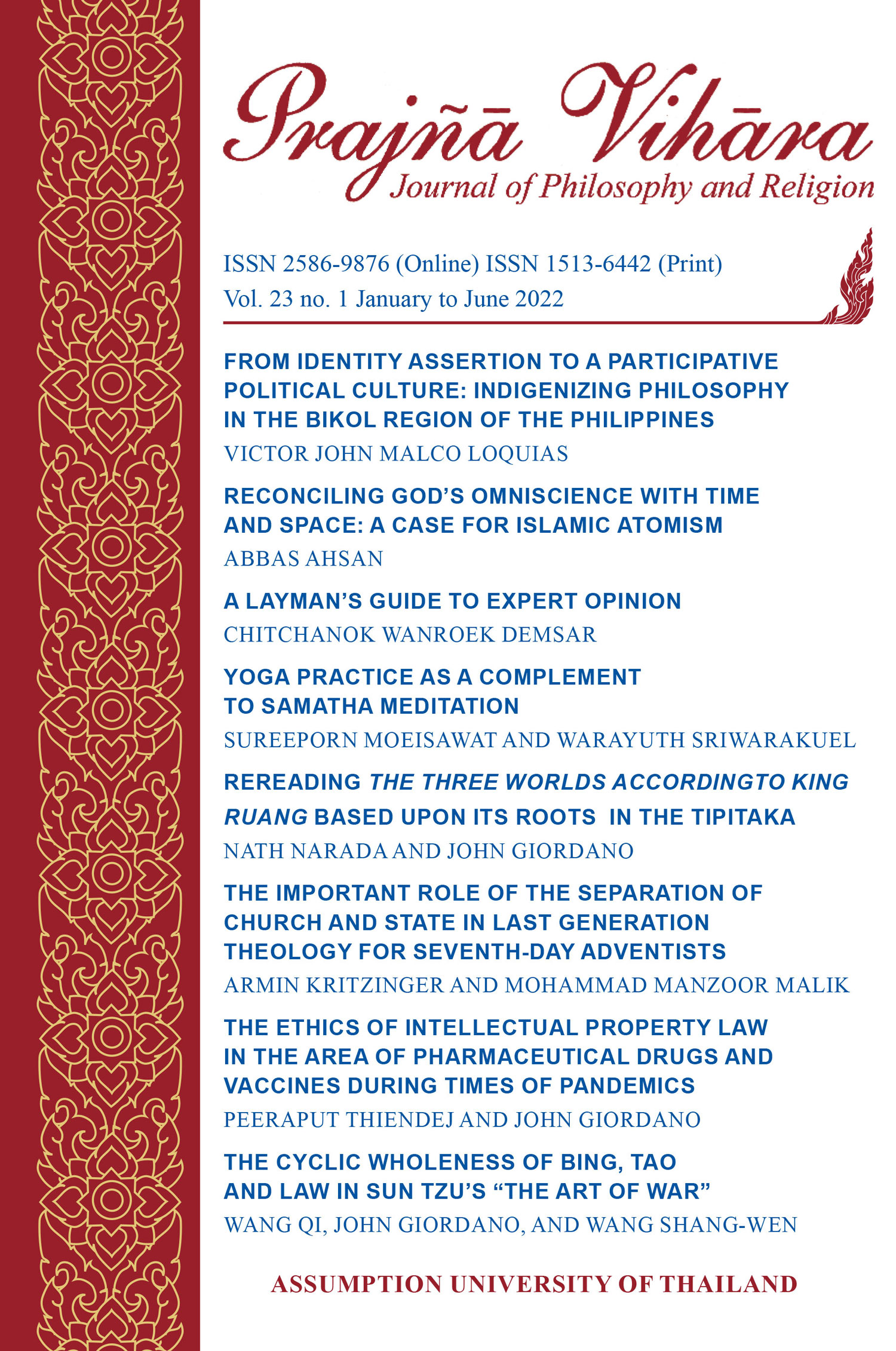REREADING THE THREE WORLDS ACCORDING TO KING RUANG BASED UPON ITS ROOTS IN THE TIPITAKA
Abstract
This paper is a study of Thai Buddhist cosmology
contained in the old manuscript named, the Traibhumikatha
(Tebhumikatha). This manuscript had been compiled and
revised for first public edition in 1912. The final text was
entitled the Trai Phum Phra Ruang and it has been translated
into English in 1979 as The Three Worlds According to King
Ruang. The dissemination of this text began since the rise
of Thai kingdom, thus it is regarded as one of the literary
classics of Thai culture. The text has often been interpreted
as an attempt to make Theravada Buddhism more accessible
to the masses. It subsequently has been appropriated by
folk culture as documenting the literal existence of heavens
and hells and the accumulation of merits through several
lifetimes. This paper aims to move beyond this more
superficial reading of text to a deeper interpretation based
upon the concept of impermanence (Anicca) which is a
dominant concept of Theravada Buddhism. Impermanence
represents a cosmological view based on the law of three
marks of existence (Tilakkhana). It also determines the
features of time, space, and beings as contingent and not
independent of other things. Therefore, it is used in this
study as a key to disclose a new meaning of this text based
upon its deeper narrative, the Tipitaka. And with the notions
Nath Narada and John Giordano 73
applied from Schleiermacher’s hermeneutical theory, the
rereading of this text represents an attempt to fill the gaps in
the traditional interpretation which overlooks the attainment
of Nibbana at present lifetime and in modern interpretation
which lacks a sociocultural dimension.
References
Bhikkhu, Buddhadasa. Heartwood of the Bodhi Tree. Boston: Wisdom
Publications, 2014.
Klemm, David E. Hermeneutic Inquiry, Volume I: The Interpretation of
Texts. Atlanta: Scholars Press, 1986.
Lithai, Phya. The Three Worlds According to King Ruang. Translated by
Frank E. Reynolds and Mani B. Reynolds. Berkeley: University
of California, 1982.
Wittgenstein, Ludwig. Philosophical Investigations. Translated by G. E.
M. Anscombe, P. M. S. Hacker, and Joachim Schulte. Singapore:
Blackwell Publishing, 2009.
Thai books
พุทธทาสภิกขุ. พุทธทาสลิขิต, เล่ม 1. กรุงเทพ: สำ�นักพิมพ์สุขภาพใจ, 2541.
Buddhadasa Bhikkhu. Buddhadasa Likit, Volume 1. Bangkok:
Sukkhaphabchai Press, 1998.
พุทธทาสภิกขุ. ภาษาคน ภาษาธรรม. นนทบุรี: ศูนย์สืบอายุพระพุทธศาสนา, 2509.
Buddhadasa Bhikkhu. Phasa Khon - Phasa Tham Nontaburi: Buddhist
Dissemination Center,1966.
ปุญญานุภาพ, สุชีพ. พระไตรปิฏกสำ�หรับประชาชน. กรุงเทพ: โรงพิมพ์มหามงกุฎราชวิทยาลัย,
Bunyanuphab, Sucheeb. The Tipitaka for Layperson. Bangkok:
Mahamongkut University Press, 1996.
เมธังกร, พระสังฆราช. โลกทีปกสาร. กรุงเทพ: กรมศิลปากร, 2549.
Ibid, 2.
Phya Lithai, The Three Worlds According to King Ruang, 334.
Ibid, 346 – 347.
Ibid, 350.
Klemm, Hermeneutical Inquiry, 2.
Nath Narada and John Giordano 107
Medhankara, Phra Sangharaja. Lokadipakasara. Bangkok: The Fine Arts
Department of Thailand, 2006.
วรรณปก, เสฐียรพงษ์. จากเสถียรพงษ์ วรรณปก ถึง พระเทพเวที และพุทธทาสภิกขุ. กรุงเทพ:
ช่อมะไฟ, 2532.
Wannapok, Sathianphong. From Sathianphong Wannapok to Phra
Thepwethi (P. A. Payutto) and Buddhadasa. Bangkok: Chormafai
Press, 1989.
Websites
Baums, Stefan. “Gandharan Scrolls: Rediscovering an Ancient
Manuscript Type.”
Accessed 26/03/2022. https://stefanbaums.com/publications/
baums_2014_3.pdf
Eoseewong, Nidhi. “ธรรมยุตของธรรมยุต” (Dhammayuttika Nikaya).
Accessed 29/03/2022. https://prachatai.com/
journal/2016/10/68495
Fumio, Enomoto. “The Discovery of The Oldest Buddhists Manuscripts.”
Accessed 26/03/2022. https://core.ac.uk/download/pdf/267922585.
Suttacentral. “Bahiya Sutta.”
Accessed: 13/02/2022. https://suttacentral.net/sn35.89/en/sujato
Suttacentral. “Mangala Sutta.”
Accessed: 16/03/2022. https://suttacentral.net/kp5/en/
piyadassi?reference=none&highlight=false
Wikipedia. “Early Buddhist texts.”
Last modified 18/01/2022. https://en.wikipedia.org/wiki/Early_
Buddhist_texts .
Prajñā Vihāra Vol. 23 no. 1 January to June 2022
Illustrations
Figure 1, Thai Inscription Database. “Sukhothai inscription at the base
of Phra I-suan of Kampaengphet.”
Accessed 29/04/202. https://db.sac.or.th/inscriptions/inscribe/
image_detail/26013
Figure 2, Bangkok National Museum. “Hindu gods statues of Sukhothai.”
Accessed 21/04/2022. https://www.
facebook.com/nationalmuseumbangkok/
photos/a.165319730186928/5395124507206398
Downloads
Published
Issue
Section
License
Consent to Publish and Transfer of Copyright
By publishing in Prajñā Vihāra, the author agrees to transfer and assign to Assumption University of Thailand as the Publisher of the Journal, the copyright to the Article in any form, including any and all rights, interests and claims related to it.
The author does retain the following rights:
- The right to make further copies of the published article for their use in classroom teaching.
- The right to reuse all or part of the published article in a compilation of his or her own works or in textbooks of which they are the author or coauthor.
- The right to make copies of the published article for internal distribution within their academic institution.
- All proprietary rights other than copyright, such as patent rights.
- The Article is his or her original work, and has not been published previously and is not under consideration for publication elsewhere.
- It does not contain any matter that is obscene, libelous, or contrary to law.
- They have obtained the necessary license or written authority and paid any and all related fees for the use and reproduction of text, tables, illustrations and other copyrighted work from the owners of the intellectual property rights, and can furnish the Publisher copies of the license/written authority and proof of payment of related fees upon the signing of this Agreement.
- They have the consent of the Co-Authors of the article upon the signing of this Agreement.
- In the event that they intend to republish, reprint or translate all or part of the Article in other publications, they will secure the prior written permission from the journal Editor.
Prajñā Vihāra adopts the Creative Commons Attribution (CC BY-NC-ND) license


